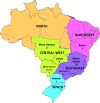The Brazilian TP53 mutation (R337H) and sarcomas
- PMID: 31978118
- PMCID: PMC6980636
- DOI: 10.1371/journal.pone.0227260
The Brazilian TP53 mutation (R337H) and sarcomas
Abstract
Sarcomas represent less than 1% of all solid neoplasms in adults and over 20% in children. Their etiology is unclear, but genetic susceptibility plays an important role in this scenario. Sarcoma is central in Li-Fraumeni Syndrome (LFS), a familial predisposition cancer syndrome. In Brazil, the high prevalence of p.Arg337His mutations in the TP53 gene brings about a unique condition: a cluster of LFS. In the present work, we studied 502 sarcoma patients not selected by age or family history in an attempt to assess the impact of the so-called "Brazilian germline TP53 mutation" (p.Arg337His) on this tumor type. We found that 8% of patients are carriers, with leiomyosarcoma being the main histologic type of sarcoma, corresponding to 52.5% of the patients with the mutated TP53 gene. These findings emphasize the importance of genetic counseling and can better guide the management of sarcoma patients.
Conflict of interest statement
The authors have declared that no competing interests exist.
Figures





References
-
- Fletcher CDM (2013) World Health Organization., International Agency for Research on Cancer WHO classification of tumours of soft tissue and bone. (4th) IARC Press, Lyon
-
- Li FP, Fraumeni JF Jr. (1969) Rhabdomyosarcoma in children: epidemiologic study and identification of a familial cancer syndrome. J Natl Cancer Inst 43: 1365–1373. - PubMed
Publication types
MeSH terms
Substances
LinkOut - more resources
Full Text Sources
Medical
Research Materials
Miscellaneous

